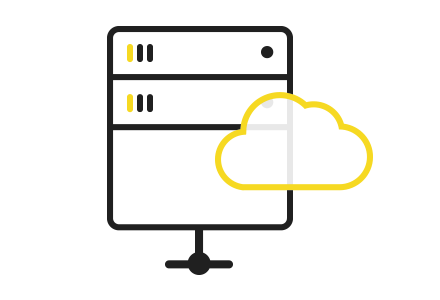cPanel and Plesk Panels
To facilitate your business and enable you to administer your web hosting environment easily and promptly, you can use cPanel or Plesk panels. These tools allow you to manage the available features on your domains with ease and immediacy. Install them on your server now and enhance their capabilities with additional options.


Plesk e cPanel for effective Web Hosting
Effective web hosting management is crucial for online success, and choosing the right control panel can make a difference.
Plesk and cPanel are designed to transform the management of websites and servers into a simple and controlled experience, offering flexibility, power, and security.
These panels provide an intuitive and centralized interface designed to make web hosting management comfortable and straightforward. By offering a centralized and intuitive area, Plesk and cPanel eliminate the need for command-line management.
Additionally, by choosing Seeweb, you have the advantage of directly purchasing licenses, ensuring immediate access and dedicated support for these tools.
Installation on products
Some of our products come with pre-installed licenses: Plesk is installed within our Shared Hosting, while cPanel is integrated into Cloud Hosting.
For cloud and dedicated server services, you have the option to choose the platform that suits you by contacting our sales department
Multi-Domain management
The panels are an optimal solution for those managing multi-domain hosting, websites, and databases, thanks to their ability to handle multiple domains and applications from a single intuitive interface.
This way, users can easily switch between domains, optimizing time and managing various settings centrally.
Plesk vs cPanel
Although Plesk and cPanel have strengths and weaknesses, they mainly differ in their user interfaces and compatibility with different operating systems.
Plesk is a versatile web hosting control panel, compatible with both Windows and Linux servers. Its interface, offering role-based access to users, allows full control of websites. This flexibility makes Plesk particularly suitable for a variety of hosting environments, from individual websites to large-scale business solutions.
cPanel, designed for Linux environments, offers automation tools and an intuitive User Interface (GUI). This makes it ideal for simplified management of websites and servers, with a focus on ease of use and operational efficiency.
Why choose Plesk?
Plesk is the most widely used panel for managing Cloud Servers and websites. Compatible with Linux, Windows, and most CMS, it includes the WordPress Toolkit and over 100 extensions for secure and professional management.
Compatibility. Plesk is versatile for different user types as it is compatible with both WordPress and Linux.
Intuitive user interface. It offers a clean and easy-to-use graphical interface, managing WordPress instances.
WordPress toolkit. Includes specific tools for WordPress management, making it easier to manage sites based on this CMS.
Extensions and customizations. Availability of numerous extensions and the ability to customize the user experience.
Why choose cPanel?
cPanel is the simplest Linux-based panel for configuring, monitoring, and managing servers and websites. It includes Softaculous App Installer for easy installation of over 200 applications, including WordPress.
Portability. cPanel is one of the most used and recognized panels in the hosting industry, offering various automatic tools for content migration optimization from other providers.
Ease of use. Famous for its user-friendly, simple, and intuitive interface, making centralized domain management easy even for non-technical users.
Monitoring. cPanel offers a control system that allows users to check the actual usage of disk space, optimizing resources.
Feature-rich. It offers a wide range of functions for web hosting management.

-
What is Plesk?
Plesk is a popular web server control panel for managing web servers. It provides a user-friendly graphical interface that allows website administrators, resellers, and end-users to control various aspects of their servers, websites, and accounts easily and intuitively. -
What is cPanel?
cPanel is a popular web control panel used in web hosting to manage the resources of your website and servers. It provides a graphical interface and automation tools to simplify the process of hosting a website. cPanel allows you to manage domains, organize web files, create email accounts, and install web applications like WordPress. It is widely used for its ease of use and its ability to automate many complex tasks related to website and server management. -
What is Plesk used for?
With Plesk, you can easily:
- Manage domains and subdomains. Configure and manage one or more domains, along with their related subdomains.
- Administer email hosting. Create and manage email accounts, spam filters, and redirection rules.
- Install and manage web applications. Use tools like Wordpress, Joomla, or Drupal to create and manage web content.
- File management. Upload, edit, and manage files and folders directly through the Plesk interface.
- Manage databases. Create and manage MySQL or PostgreSQL databases.
- Security. Implement SSL/TLS certificates, configure firewalls, and other settings to ensure the security of the site and server.
- Backup and restore. Perform site and database backups and restore them when needed.
- Monitoring and statistics. Monitor server resource usage and view detailed statistics.
-
What is cPanel used for?
cPanel has various features:
- Domain management. cPanel allows you to manage domains and subdomains, configure domain redirects, and modify DNS settings.
- Email management. You can create and manage email accounts, configure anti-spam filters, set up autoresponders, and more.
- File management. It provides a file manager for uploading and managing files on the server, managing backups, and configuring FTP access.
- Database. It allows you to create and manage MySQL or PostgreSQL databases and provides tools for database management and optimization.
- Security. cPanel offers various security options such as password protection for directories, SSL certificate configuration, and IP blocking.
- Software and applications. You can easily install and manage software and web applications like WordPress, Joomla, and Drupal through Softaculous or other automatic installers.
- Monitoring. You can monitor server resource usage, such as disk space and bandwidth, and view statistics and error logs.
- Advanced management. Includes advanced tools like cron job access for task automation, PHP version management, and more.


